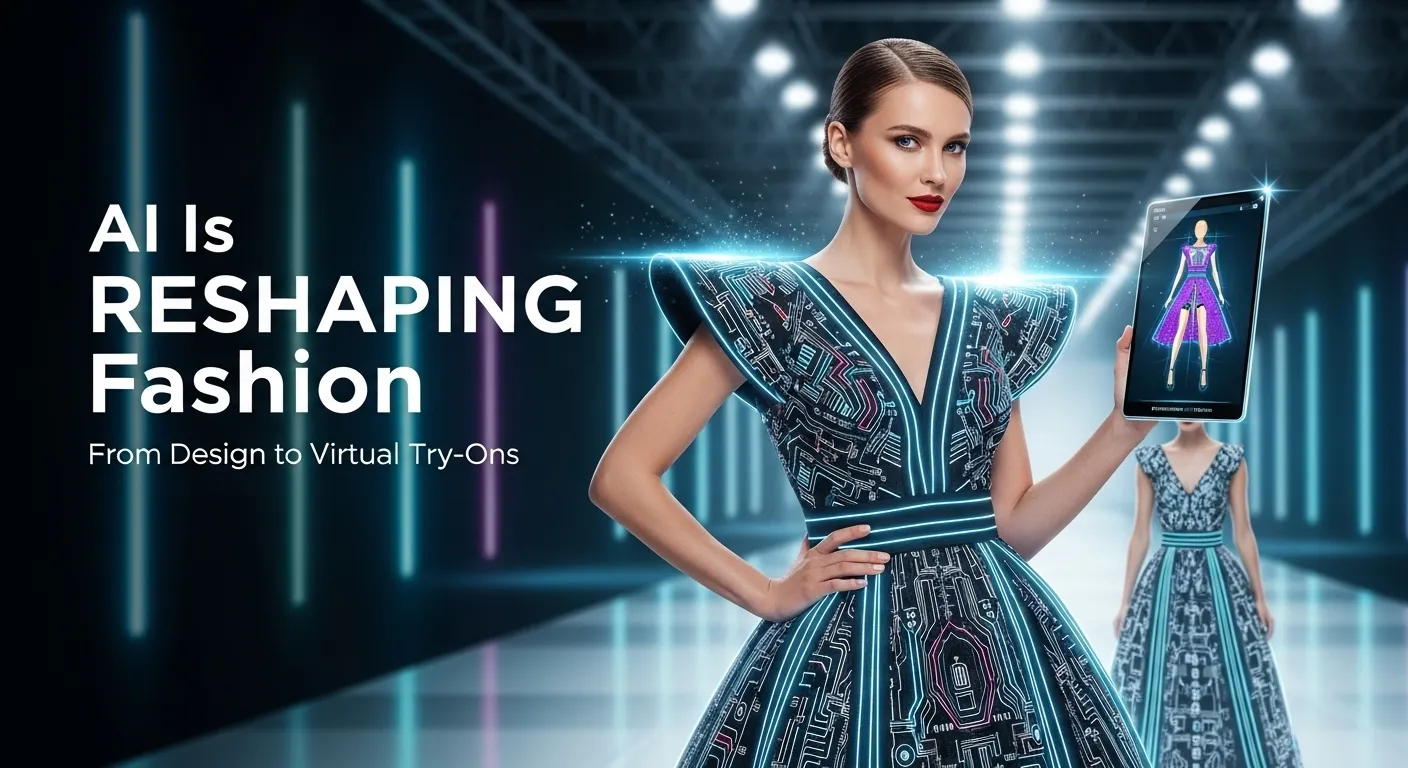Forget waiting six months to see if a trend will stick. Artificial intelligence is turning the fashion industry’s seasonal guessing game into a real-time science. Welcome to the new era of style, where algorithms design your next favorite dress and virtual mirrors know your size better than you do.
What Is AI in Fashion?
AI in fashion is like having a super-powered creative director who never sleeps, eats, or takes coffee breaks. It’s the application of artificial intelligence technologies—from machine learning to computer vision—to design clothing, predict trends, and create personalized shopping experiences. Think of it as fashion’s digital brain, analyzing everything from runway shows to Instagram posts to predict what you’ll want to wear next season.
How AI Fashion Technology Works
The magic happens through three main channels:
Generative Design: AI algorithms analyze thousands of historical designs, current trends, and cultural references to generate entirely new clothing concepts. Tools like Midjourney and DALL-E can create hundreds of design variations in minutes that would take human designers weeks.
Trend Forecasting: Machine learning models scrape social media, search trends, and sales data to identify emerging patterns. These systems can predict color trends, fabric preferences, and even specific garment styles months before they hit mainstream consciousness.
Virtual Try-Ons: Using computer vision and augmented reality, these systems map your body measurements from photos or camera feeds to create accurate virtual fittings. Advanced algorithms account for fabric drape, stretch, and how different materials behave on various body types.
Benefits & Use Cases
- Reduced Waste — Brands like Zara and H&M use AI to produce only what sells, cutting overproduction by up to 30% according to recent industry reports
- Hyper-Personalization — Stitch Fix’s AI stylists analyze your preferences to curate boxes you’re actually excited to open
- Faster Time-to-Market — Traditional 18-month design cycles shrink to mere weeks when AI handles trend analysis and initial design concepts
- Better Fit Experiences — Virtual try-ons reduce return rates by 40-50% for early adopters like ASOS and Warby Parker
Costs & Implementation
AI fashion solutions range from accessible to enterprise-level investments. Basic virtual try-on APIs start around $0.10-0.50 per try-on session, while comprehensive trend forecasting platforms can cost $5,000-50,000 monthly for major retailers. Many brands are finding the ROI compelling—reduced returns alone often cover the technology costs within the first year.
Local Insights: US Market Adoption
American fashion retailers are leading the AI charge, with Nordstrom’s “See Your Fit” technology and Macy’s virtual try-on partnerships setting the standard. The US market sees particularly high adoption in denim and eyewear categories, where fit matters most. Interestingly, regional preferences emerge too—AI analysis shows West Coast shoppers prefer sustainable brands, while East Coast fashion leans more traditional.
Traditional vs AI Approaches
- Traditional Design: Relies on designer intuition and small focus groups. Pros: Human creativity, emotional connection. Cons: Slow, expensive, high failure rate.
- AI-Assisted Design: Data-driven creation with human oversight. Pros: Scalable, data-backed, reduces risk. Cons: Requires technical expertise, can feel “generic” without careful curation.
- Traditional Forecasting: Industry reports and trend-spotting. Pros: Established methodology. Cons: Often outdated by publication.
- AI Forecasting: Real-time data analysis from multiple sources. Pros: Immediate insights, predictive accuracy. Cons: Can miss cultural nuances without human interpretation.
Step-by-Step: Implementing AI Fashion Solutions
- Audit Your Needs — Identify whether you need design assistance, trend forecasting, or customer-facing try-on technology
- Choose Your Tools — Select from established platforms like Vue.ai for try-ons or Heuritech for forecasting, or build custom solutions
- Integrate Carefully — Blend AI insights with human expertise—use algorithms for data analysis but keep designers in the creative driver’s seat
- Test Extensively — Run parallel collections (AI-designed vs traditional) to compare performance before full commitment
- Scale Gradually — Start with one product category or region before rolling out across your entire operation
FAQs
Will AI replace fashion designers?
Not likely—but it will transform their role. AI excels at pattern recognition and generating options, but human designers provide the emotional intelligence, cultural context, and creative vision that algorithms can’t replicate. Think of AI as the ultimate assistant, not the boss.
How accurate are virtual try-ons?
Current technology achieves 85-95% accuracy for standard clothing items. The most advanced systems account for fabric stretch, drape, and even how garments move. For best results, users should follow measurement guidelines carefully and wear form-fitting clothing when scanning.
Is AI fashion technology affordable for small brands?
Increasingly yes. Many SaaS platforms offer tiered pricing, and open-source computer vision tools make basic implementation possible for tech-savvy small businesses. The cost of not adopting? Potentially being left behind as customer expectations evolve.
Bottom Line
AI isn’t just changing how clothes are designed and sold—it’s rebuilding the entire fashion ecosystem from the algorithm up. The brands that thrive will be those that blend data-driven insights with human creativity, creating better experiences for shoppers and more sustainable practices for the planet. The future of fashion isn’t just human or machine—it’s both, working in perfect harmony.

